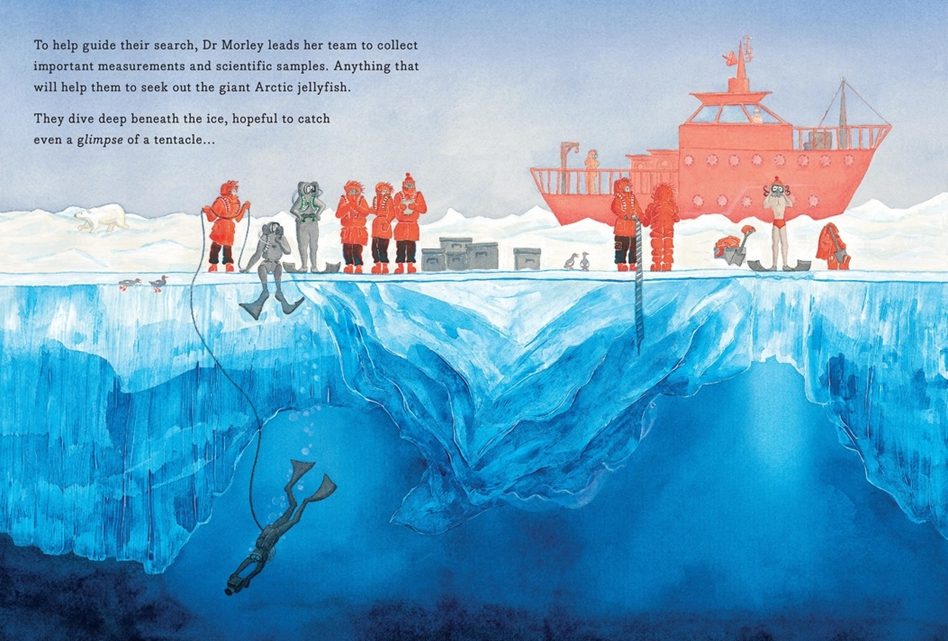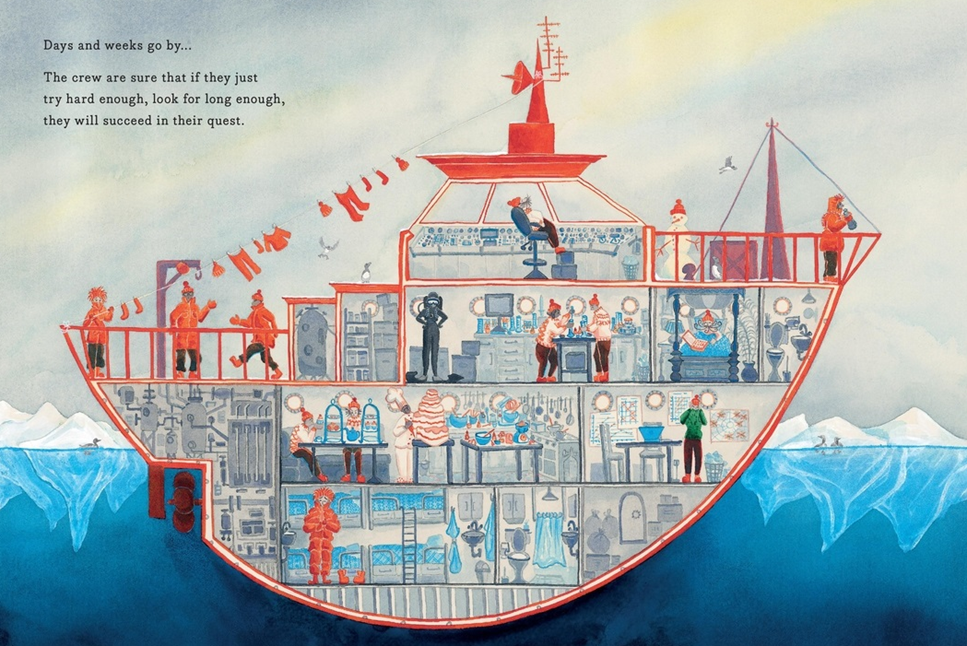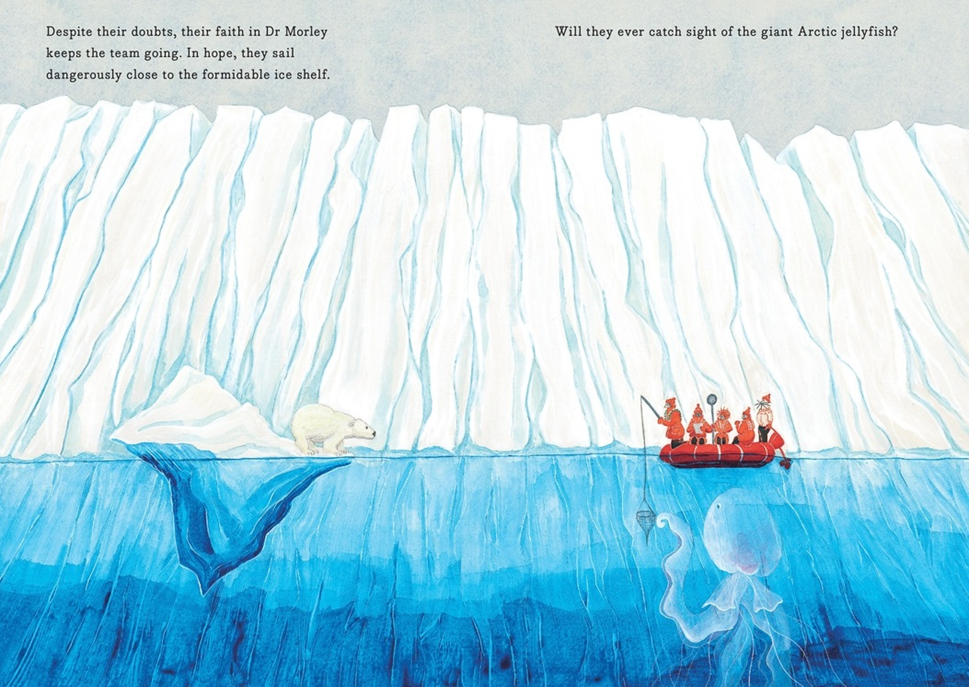Chloe Savage


About Author
Chloe Savage was born and raised in Stevenage. She has a First Class BA Honours in TV and Film Set Design from Cardiff and an MA in Children's Book Illustration from The Cambridge School of Art. She has worked for a number of years in opera, film and television. While doodling on call sheets, Chloe found her way to her great love of illustration and storytelling.
Chloe is a great lover of food and the seaside, she currently lives in Hitchin with her husband and has never been happier. Find her on Instagram @chloe.the.savage.
Interview
The Giant Arctic Jellyfish (Walker Books)
October 2023
In this story of hope and endurance, we follow a scientist and her team during their search for the elusive 'Giant Arctic Jellyfish'. Young children will delight in spotting the Jellyfish hidden on the pages, while the message of perseverance and hope will speak to all ages.
The Giant Arctic Jellyfish is a stunning picture book with incredible artwork by debut picture book creator, Chloe Savage. Here, she tells us more about the inspiration behind her picture book and why its story, about failure and resilience, is such an important one for children to hear:
Q&A with Chloe Savage
"The Search for Giant Arctic Jellyfish is the story of Dr Morley's resilience and perseverance in the face of her failure to achieve her dream."
1. Thank you for joining us on ReadingZone to talk about The Search for the Giant Arctic Jellyfish. Can you start by telling us a little about yourself, how you became an author and illustrator, and the kinds of books you aim to create?
I worked in Opera, Film and TV before I did my MA Children's Book Illustration at the Cambridge School of Art and had the opportunity to do what I love full time.
The kind of books I like to create are rich in detail. The idea being that regardless of reading level, or age, everyone reading my books will find something of interest. As someone who struggled with reading growing up, it is enormously important that the interest in my books is inclusive in this way.
2. How has your training in theatre and film design influenced your work as an illustrator?
My experience of film and theatre highly influences my work. The picture book as a physical object is essentially a tiny stage. In all my varied experience, the common thread is storytelling through the union of words and pictures. I see the influence most strongly in my composition of images; interestingly this is changing as I develop as an author / illustrator.
3. What is your book, The Search for Giant Arctic Jellyfish, about?
The Search for Giant Arctic Jellyfish is the story of Dr Morley's resilience and perseverance in the face of her failure to achieve her dream. It is also the story of our great gentle Jellyfish and their shyness in approaching new friends. This is very much a story about failure.

"The inspiration for Dr Morley and her crew's search very much draws on my own experience of suffering, desolation and terrible food on film sets."
4. What inspired the story of scientists looking for a mythical / elusive creature of the deep?
The original inspiration behind the Jellyfish Character came nearly ten years ago. I was working on a docudrama in a dingy north London warehouse in the middle of winter and my sister, who was working abroad at the time, was sending me pictures of a beautiful lagoon in northern Thailand. Perhaps it was escapism that brought out my love of the sea, but that was when I started doodling jellyfish on my call sheets, solving all my problems. Since then, the inspiration for Dr Morley and her crew's search very much draws on my own experience of suffering, desolation and terrible food on film sets.
5. Do you choose to write about what you would like to illustrate? How does the process of bringing together words and pictures work for you?
To a certain extent, yes, I make stories about things which I enjoy to paint. However, I will frequently have an idea of an image in my mind, and have to go through a process of experimentation to find out if I actually can paint it.
The words and the pictures are very much simultaneous for me, and I love both equally. I find it very hard to edit the text as a separate sheet, because the text is one half of the whole. For The Search for the Giant Arctic Jellyfish, I always knew that the text should be sparse with a feeling of simple rhythm. However, for my second book, The Search for Carmella, I began with way too much text which we had to cut down more and more. In both cases, I cannot work on the words and pictures separately; the stories always appear in my mind as words and pictures together.
6. What about the information we learn about arctic exploration through the images - how much research did you need to do for the illustrations of this book?
I always do a lot of research. It is never possible for me to visit the actual places I am making books about, and there is no substitution for the inspiration that would bring. So I research as thoroughly as possible, looking for little details to bring to the work. The Search for the Giant Arctic Jellyfish is very much a work of fiction, but it was important to avoid any jarring zoological errors which would break your suspended disbelief.

"Even children too young to read independently can be absorbed by all the little moments in the cross sections; it is very important to me that my books should be inclusive to readers of all abilities in this way."
7. The giant arctic jellyfish is a very endearing and playful being - how did their personality and 'look' develop?
I love to take old sketchbook paintings of the Jellyfish into schools to show the children the evolution of the character, from sinister little eyes to a great gentle giant.
Their personality developed through the process of experimenting with how to paint their translucence. As a silent creature, their emotions are expressed through their body language and eyes. That sense of their personality developed very naturally from the thought of how would a "good egg" of a jellyfish live in this environment and in this Arctic community.
I often have interesting discussions with children about the gender of the jellyfish, because we see a myriad of emotions from the jellyfish, sometimes deeply shy, playful, or firm and assertive with the Orca. I do not think that their gender matters in the least, this is about universal feelings and shared experience - just as science should be the universal pursuit of seeking knowledge and understanding for the good of our planet as a whole.
8. There is also a lot of humour in the illustrations, like all the matching jumpers and the snowman, in addition to the hidden jellyfish images. Why do you want to have these moments in the book?
The book is absolutely full of hidden details. I have always hidden little 'Easter eggs' in my work since my very first job, and it is something I will always bring to my books, too. There will always have to be some levity in my work to bring balance, because the real world is scary enough as it is.
I love highly detailed books with layers of sub-stories in the images. The chef, for example, is inspired by my own experience of horrific film catering. I was once handed a plate with a fried egg and the yolk rolled independently off the white. Or, for example, in the northern lights spread; my cousin had just proposed to his girlfriend, so I added them on the deck and now their children can go in the book and find their Mum and Dad there. My nephew loves to point out his dog sitting on the dock.
Even children too young to read independently can be absorbed by all the little moments in the cross sections; it is very important to me that my books should be inclusive to readers of all abilities in this way. I often receive messages from parents who love the humour in the details. It makes me inexpressibly happy that adults enjoy the book together with their young people.
9. How do children respond to the 'hide and seek' element of the book? What do they most enjoy about it?
Reading the book with children is an absolute joy. They love finding out where the jellyfish is and feeling more clever than the scientists. We always end up with a big discussion about the ending and whether or not they see each other, there is always a surprising balance between optimism and pessimism. I am often sent photos of kids curled up on their own with the book going through all the details in the cross sections, it brings me so much happiness to see.

"Reading the book with children is an absolute joy. They love finding out where the jellyfish is and feeling more clever than the scientists."
10. How did you decide on the style of illustration for this book, including the colour palette - and how did you create the illustrations for it?
I create all my art in a combination of watercolour and acrylic ink, I generally keep Photoshop tweaks to an absolute minimum. The limited palette was a natural evolution from the colour blue I wanted for the water and finding its complimentary red, so that there are no true blacks in the book, just the complimentary dark grey.
The process of developing the art for Jellyfish was unusually long. I had made one version of the book for my MA final project, I then developed the book again when I joined my (sublime!) editors at the publisher, Walker Books, and I had finished a good set of colour roughs when I was diagnosed with cancer and took an eight month break.
When I came back to work, my hands were still shaky so I made a set of small A4 colour roughs, which were less physically demanding. After such a big break, the art naturally went through another phase of improvement. The paintings are built up in many layers which need good drying time, so I will generally paint three or four pieces at the same time. I love painting the water over the ice; the originals are even more lovely than the printed work.
And finally.... Are you working on other picture books currently? Can you tell us a little about your next project?
My second picturebook is The Search for Carmella [publishing November 2024], it is about Dr Rose learning to find joy in the act of searching. She learns that the journey is not about an end goal, but a way of living life. This adventure takes us into the deep sea to find bioluminescent creatures in the dark, and perhaps if we are lucky, a peak at the colossal bright pink Carmella. I have begun work on my third book, which is an adventure into outer space in search of Life; so far it is about frustration and communication.
I work in my studio which is a room in our little attic flat. The eaves of the roof come down over my desk, but I have good light from a north facing skylight. It's very compact, so as the process of making art moves along, I pin a string around our corridor and peg up the paintings. This is not just essential storage, I also find it helpful to live with the art for a while, to see it from different angles, and this has become an important part of my process.
 The Search for the Giant Arctic Jellyfish
The Search for the Giant Arctic Jellyfish
